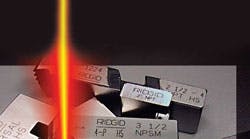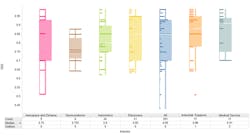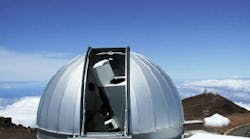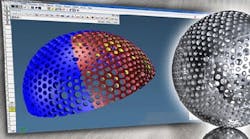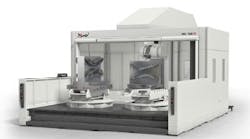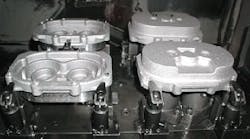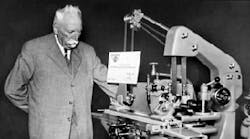Laser marking of tools, workpieces and components offers advantages in many applications. The process is flexible, it offers several methods of permanently marking surfaces; it is a safe and environmentally friendly; it can be applied to flat, curved and unusually shaped objects made from any of a variety of materials and it can be used with materials that may be damaged by other marking methods.
Laser marking is a noncontact, thermal process relying on the heat generated by the laser beam to alter the surface of the workpiece. As its acronym name implies (Light Amplification by Stimulated Emission of Radiation), lasers amplify light by absorbing and emitting energy in the form of a high-intensity beam of laser light.
All lasers consist of a lasing medium that contains atoms that can be stimulated to spontaneously emit light.
The medium may be a gas mixture – CO2 or helium-neon, for example; semiconductor substrate – laser diodes; a liquid – dye lasers; or a solid crystal — such as neodymium: yttrium aluminum garnet (Nd:YAG ), neodymium: yttrium lithium floride (Nd:YLF) or ruby. Lasers also have an energy source to excite – or pump – the atoms of the media. The pump source usually is an electric discharge, light from a hi-intensity light source, or light from another laser.
Solid-state Nd:YAG lasers are used to mark a variety of metallic and nonmetallic materials, and usually are used for beam-steered laser marking.
These systems deflect the laser beam across the surface much like a pencil on paper. Where the pencil deposits lead, the high-intensity laser light alters the workpiece material to create a contrasting image.
System Control
To achieve the desired results, beamsteered Nd:TAG marking systems provide operators with several means of controlling the thermal reaction either manually and/or by computer control.
Increasing or decreasing the electric current to a krypton arc lamp adjusts the output power of the laser. As the current changes, the light output from the lamp and the rate of laser amplification increases or decreases accordingly.
After establishing the overall quantum of light amplification with the lamp current, the operator may adjust the Qswitch pulse rate. The Q-switch effectively divides the laser output into pulses of light. To best understand the phenomena, visualize the Q-switched laser as an optical capacitor. Much like an electric capacitor, the laser stores energy during the nonlasing periods between pulses.
When the laser is pulsed by the Qswitch, the output is a burst of light that contains most of the stored energy.
If the pulse rate is set to a low frequency (1 kHz), the comparatively long duration between pulses produces very high peak power pulses with very narrow pulse widths (about 100 nanoseconds). If the pulse rate is increased to 10 kHz, the peak power will be lower due to the shorter charge time between pulses.
The high peak power pulses at low frequencies rapidly increase the workpiece surface temperature to vaporize material with minimal heat conduction into the part.
At higher pulse rates, the lower peak power produces less, if any, vaporization, but results in significantly more heat conduction.
The greater number of pulses in a given timeframe also increases the heat conducted into the work surface.
The Q-switch pulse rate is probably the most important variable for control of the thermal process. As with the lamp current, the pulse rate can be controlled either manually or by the part program
After the laser output has been configured with the lamp current and pulse rate, the operator must establish the beam velocity – the marking speed.
In a perfect world, every application would run at maximum speed for the highest system throughput.
In laser marking however, the beam velocity is another important variable in the thermal process and must be set to achieve the desired process results.
For deep marking, typically greater than 0.002 in., each point on the engraved line will require exposure to several pulses to achieve depth. Beam velocity must be reduced until the desired depth is achieved.
For shallow marking, the speed may be increased to the system’s maximum velocity or until the separation between pulses is aesthetically unacceptable at the selected pulse rate setting.
As a general rule, pulses should overlap at least 50 percent to give the appearance of a continuous engraved line.
Material Considerations
Nd:YAG lasers are compatible with a wide variety of materials for laser marking. Some of the material characteristics that affect the process include reflectivity, absorption characteristics, thermal conductivity, workpiece color and surface finish.
The laser light must be absorbed to generate heat. If the target material is highly reflective to the laser wavelength, it may require that the power be increased, the pulse rate decreased for higher peak power or the beam velocity reduced.
If the material is too reflective, it may not mark at all.
Most metallics are absorptive to the Nd:YAG 1.06-mm wavelength and can be readily marked. Gold is highly reflective and requires more power. Some organic materials such as wood and paper are almost 100 percent reflective and therefore are unmarkable.
If reflectivity is a problem, it is possible to double the frequency of the laser to operate at the green, 532 nm wavelength. That may produce better results. A marking system using a CO2 laser with a wavelength of 10.6 microns (far-infrared) also may produce acceptable results.
The percent absorption of all materials varies with changes in temperature. Because the laser marking process increases the surface temperature, materials that exhibit a significant increase in absorption may not be markable.
For example, some plastics exhibit such steep absorption-to-temperature curves that it is almost impossible to achieve an aesthetically acceptable mark. The surface temperature and the percentage of absorption begins to increase on initial exposure to the marking beam. Unfortunately, as a greater percentage of the laser output is absorbed, the rate of the temperature rise increases causing the percentage of absorption to increase even further.
The material reactions can runaway in a matter of milliseconds. If the laser power is reduced in an attempt to compensate and regain control of the process, there may be insufficient absorption to achieve the initial temperature increase, and the plastic will not respond to the laser at all. The alternate wavelengths of frequency-doubled Nd:YAG or CO2 may effect a more controllable curve should this problem arise.
High thermal conductivity does not completely inhibit laser marking, but it may make it more difficult to achieve the desired results. Highly conductive materials convey heat away from the point at which the laser is attempting to increase the temperature resulting in a slower temperature rise with the loss of heat to the surrounding area. Laser parameters have to be adjusted to compensate for materials’ attempts to “heat sink” themselves.
Aluminum is a classic example of this characteristic. Compared with steel, aluminum requires more power and/or slower marking speed to achieve equivalent results.
Dark colors absorb more laser light than lighter colors, although the difference usually is marginal and requires minor adjustment to the laser output power, the marking speed or the its pulse rate.
Paints and other coatings usually have little effect on laser marking because lasers quickly vaporize the paint or coating to expose the color of the base material.
The surface finish of a target part is not a crucial factor in the thermal process itself but may be important for readability. If a laser does not induce a color change, a rough surface will require deep engraving to achieve a legible image with the surrounding material. A smooth, machined surface yields excellent readability with very shallow engraving.
For all practical purposes, material hardness is not a factor in laser marking. The laser can mark a hardened steel part just as readily as untempered material.
Types of Lasers
Sealed-tube CO2: Lower cost marking by surface discoloration. Suitable for plastics, paints, inks, ceramics and other nonmetallics.
Slab CO2: For deep surface modification of nonmetallics.
Diode-pumped Nd:YAG (DPSS): High quality beam and pulse stability. Narrow line width for small characters with deep material penetration.
Pulsed Nd:YAG:Very high peak pulsed power for deep engraving and wide line widths.
Frequency-tripled Nd:YAG: Ultraviolet wavelength produces narrowest line width for micromarking; optimum wavelength for several specialty materials.
Frequency-doubled Nd:YAG : Visible green wavelength for narrow line width, small-character marking; best for gold, many synthetics and plastics.
Q-switched Nd:YAG :High peak power, narrow pulse width for deep penetration marking/engraving. Optimum for most metallics and many nonmetallics.
